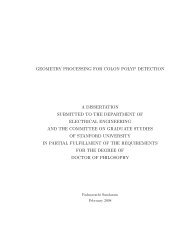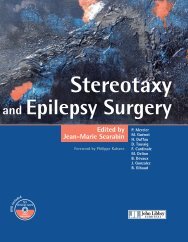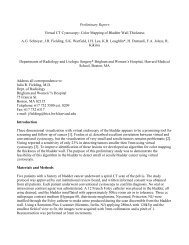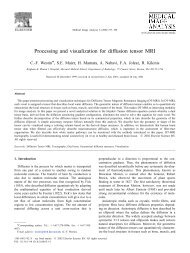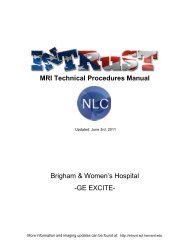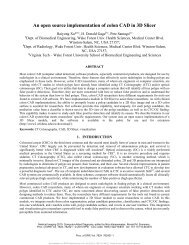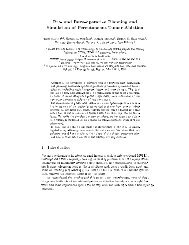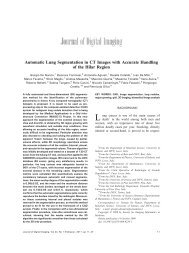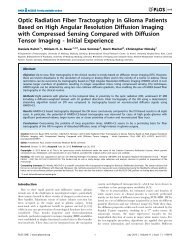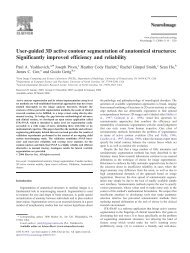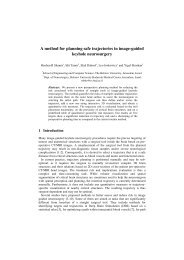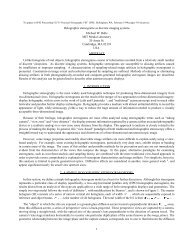(VMTK) for Coronary arteries - 3D Slicer
(VMTK) for Coronary arteries - 3D Slicer
(VMTK) for Coronary arteries - 3D Slicer
You also want an ePaper? Increase the reach of your titles
YUMPU automatically turns print PDFs into web optimized ePapers that Google loves.
Application of Vascular Model Toolkit<br />
(<strong>VMTK</strong>) <strong>for</strong> <strong>Coronary</strong> <strong>arteries</strong><br />
Christopher,J.,MD.DNB., Mohan Rao MB.,BS.,MS(USA).,Chary,Duraikannu.,<br />
DMRD.,DNB.,Kishore.,LT.,MD.,DMRD.,Krishnam Raju P MD DM<br />
Abstract<br />
Background<br />
Functional evaluation of coronary <strong>arteries</strong> involves study of their <strong>3D</strong> shapes and<br />
diameters. Segmentation of vascular structures from <strong>3D</strong>-Computerized<br />
Tomographic Angiogram (CTA) images can be achieved by using <strong>VMTK</strong>. This<br />
gives: (1) a polygonal surface model of vascular structures having centerline<br />
based geometric quantities and (2) compute centerlines and Maximal Inscribed<br />
Sphere Radius (MISR) of branching tubular structures (Voronoi image).<br />
Methods and Results<br />
<strong>VMTK</strong> module integrated in <strong>Slicer</strong>3 is used as it allows use of other <strong>Slicer</strong>3<br />
modules <strong>for</strong> processing of images. We use: VesselEnhancement,<br />
EasyLevelsetSegmentation and Centerlines modules <strong>for</strong> study. Right and left<br />
coronaries (RCA,LCA) are processed separately. Either Frangi or Sato<br />
vesselness is used <strong>for</strong> vessel enhancement of volumes. Vessel enhanced image<br />
is used as input <strong>for</strong> EasyLevelsetSegmentation. Centerline module is run to get<br />
final model and its Voronoi image. Automatically generated centerlines data<br />
gives MISR. Position of each point on a image (in X,Y and Z axes) is found<br />
using probe-position filter of Paraview. For five normal (3 female, 2 male) CTA<br />
images of heart, average of ten points each on proximal, middle and distal<br />
segments of <strong>arteries</strong> is calculated. The average MISR of RCA, LAD and left<br />
circumflex (LCX) are (in mm): proximal (1.00,1.11, 0.98), middle (0.97, 0.97,<br />
0.85), and distal (0.95, 0.92, 0.80). Average diameters <strong>for</strong> RCA (1.94), LAD<br />
(2.00), and LCX (1.64) is compared with traditional CTA measurements proving<br />
its accuracy.<br />
Conclusions<br />
The geometric details of coronary artery obtained from <strong>VMTK</strong> are superior to<br />
those of unprocessed CTA images. These images show: centerlineprep<br />
(vascular wall), Voronoi image (vascular lumen) and centerlines. It generates<br />
large (~5000) MISR data points <strong>for</strong> each coronary. Its computational analysis<br />
allows segmentation of small (1.2 pixels/diameter) vessels. Data presented here
suggests <strong>VMTK</strong> analysis of coronaries is superior to conventional studies.



